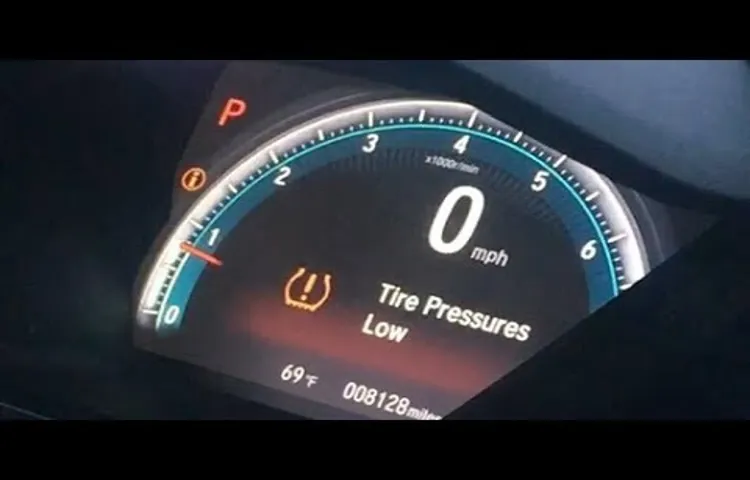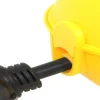Driving a Honda Civic is a pleasure, but a low tire pressure warning or a flat tire can put a damper on your ride. Most newer vehicles, including the Honda Civic, are equipped with a tire pressure monitoring system (TPMS) that keeps you informed about your tire pressure. However, sometimes your TPMS can malfunction, and you will need to know how to reset it.
In this blog, we’ll teach you how to reset the tire pressure on your Honda Civic so you can get back on the road in no time. Don’t let low tire pressure ruin your journey. Learn how to reset it with our step-by-step guide.
Table of Contents
Check Tire Pressure
If you’re wondering how to reset tire pressure on your Honda Civic, you’ve come to the right place! Maintaining proper tire pressure is crucial for safe and efficient driving, and your Honda has a built-in system to help you do just that. To reset your tire pressure, start by making sure your tires are properly inflated. Then, turn on your Civic and locate the “MENU” button on your dashboard.
Press the button until you see the “TIRE PRESSURE” option, then hit “OK.” From here, use the directional buttons to select “RESET” and press “OK” again. Finally, drive your Civic for a few miles to recalibrate the system and make sure everything is running smoothly.
It’s always a good idea to check your tire pressure regularly to prevent accidents or damage to your vehicle. Keep your Honda running smoothly by following these simple steps!
Locate TPMS Button
If you are ever in doubt about your tire pressure, one of the first things you should do is locate your TPMS button. The TPMS (Tire Pressure Monitoring System) is a feature that comes standard on most vehicles nowadays, and it helps drivers keep an eye on their tire pressure. By locating the TPMS button, you can easily check the pressure of each tire and ensure that they are all properly inflated.
In most cars, the TPMS button can be found either on the dashboard or near the steering wheel. Once you locate it, all you need to do is push the button to activate the system and check the readings. Remember that proper tire inflation is essential to safe driving, so always make sure to check your tire pressure regularly.

Turn on Ignition
“Turn on Ignition” It’s important to check the tire pressure before starting your car, as low pressure can lead to decreased fuel efficiency and decreased tire life. To start, locate the tire pressure monitoring system (TPMS) light on your dashboard. This light illuminates when your tires are underinflated.
Using a tire pressure gauge, check the pressure of each tire. You can find the recommended pressure in your vehicle owner’s manual or on the inside of the driver’s side door jamb. If the pressure is too low, use an air compressor to inflate the tires to the appropriate level.
Remember, the front and back tires may require different pressures, so be sure to check each individual tire. Once the pressure is properly inflated, you’re good to go! Remember, it’s important to check your tire pressure regularly to ensure optimal performance and safety on the road.
Press TPMS Button
One key task in maintaining your vehicle’s tires is to check their pressure regularly. This ensures your safety and the longevity of your tires. Some vehicles nowadays are equipped with a tire pressure monitoring system (TPMS), which makes the process easier.
If you own a car with a TPMS, you can check the tire pressure by pressing the TPMS button. Doing so will display the tire pressure readings on your dashboard. However, keep in mind that TPMS does not substitute for manually assessing your tire pressure.
It is still essential to check your tire pressure regularly using a tire pressure gauge, especially before long drives. Underinflated or overinflated tires can affect your vehicle’s handling and fuel efficiency, and may even cause accidents or tire blowouts. So don’t rely solely on your car’s TPMS, but always do a manual check to ensure your safety on the road.
Remember, regular tire maintenance means savings in the long run.
Reset Tire Pressure System
If you’re driving a Honda Civic, maintaining your tire pressure is crucial for ensuring your car is running smoothly and safely. Thankfully, resetting your tire pressure system is relatively easy to do on the Civic. First, make sure your tires are properly inflated to the recommended pressure.
Then, locate the TPMS (Tire Pressure Monitoring System) button, typically located on the dashboard. Press and hold the button until the TPMS light on your dashboard blinks twice. This means the system is now reset and calibrated to the current tire pressure.
It’s essential to reset the system every time you check and adjust your tire pressure to ensure accurate readings and prevent potential tire damage or accidents. So, the next time your TPMS light appears on your Civic, don’t panic! Just follow these simple steps to reset your tire pressure system and get back on the road safely and with peace of mind.
Locate Reset Button
If you’re wondering how to reset your tire pressure system, the first step is to locate the reset button. This button is usually found inside the car, often near the steering wheel or dashboard. Once you’ve found it, hold down the button for a few seconds until you see the tire pressure light start to flash.
This means the system is resetting. After a few seconds, the light should turn off, indicating that the system has been successfully reset. Keep in mind that the steps for resetting the tire pressure system may vary depending on your car’s make and model, so be sure to consult your owner’s manual for specific instructions.
Regularly checking and maintaining proper tire pressure is important for your safety and the longevity of your tires. Using a tire pressure gauge and checking your tire pressure monthly can help prevent uneven wear and tear on your tires, improve your gas mileage, and ensure a smoother ride.
Press and Hold Reset Button
If you notice the tire pressure light on your car’s dashboard flashing, it’s time to reset your tire pressure system. The first step is to press and hold the reset button until the light stops flashing. This button is typically found near the steering wheel or on the dashboard.
After holding the button for a few seconds, the light should turn off, indicating that the system has been reset. Resetting your tire pressure system is an essential step in maintaining your vehicle’s safety and performance. When tires are not properly inflated, they can wear down quickly, reducing their lifespan and causing potential hazards on the road.
By resetting your tire pressure system regularly, you ensure that your tires are always at the correct pressure level, saving you money in the long run and ensuring a smoother, safer ride. It’s important to note that resetting your tire pressure system is not a substitute for regularly checking your tire pressure with a gauge. It’s recommended to check your tire pressure monthly and adjust it as necessary, as external factors such as temperature can affect tire pressure.
In addition, if you notice that the tire pressure light continues to flash after resetting the system, it may indicate a larger issue with your tires, such as a leak or puncture. In these cases, it’s best to bring your car into a trusted mechanic for a professional inspection. Overall, resetting your tire pressure system is a quick and easy process that can help keep you safe on the road.
By pressing and holding the reset button, you ensure that your tires are always at the correct pressure level, reducing hazards and prolonging tire life. Remember to regularly check your tire pressure with a gauge and bring your car in for professional inspection if you notice any ongoing issues with the tire pressure system.
Release Reset Button
If you’ve ever had to reset your tire pressure system, you know how frustrating it can be to not know what to do. Fortunately, the solution is relatively simple: release the reset button. Most tire pressure systems have a reset button located under the dashboard.
Just press and hold this button until the tire pressure light begins to flash. Once the light stops flashing and stays on, your tire pressure system is successfully reset. It’s important to keep your tire pressure system properly calibrated to ensure your safety while driving.
By regularly checking and resetting the system, you can optimize your tire pressure and increase your vehicle’s performance. So next time you need to reset your tire pressure system, don’t panic – just remember to release that reset button!
Verify Reset
If you’re wondering how to reset the tire pressure on your Honda Civic, you’re in luck. The process is actually quite simple and can be done in a matter of minutes. First, locate the reset button on your dashboard.
It should be located near the steering wheel and marked with a small tire symbol. Once you’ve found it, press and hold the button until the tire pressure light blinks twice. Next, start your car and let it run for a few minutes to allow the system to recalibrate.
Finally, check your tire pressure using a tire pressure gauge and adjust as needed. This process ensures that your Honda Civic’s tire pressure monitoring system is working properly and keeps you safe on the road. So, the next time your tire pressure light comes on, don’t panic – just follow these simple steps and you’ll be back on the road in no time.
Check Tire Pressure Readings
Checking the tire pressure readings on your vehicle is an essential part of regular maintenance and something that should be done frequently. It is vital to ensure that you maintain the proper tire pressure recommended by the manufacturer to prevent uneven wear on the tires, which can lead to issues down the road. One thing to be mindful of when checking tire pressure is to make sure you verify the reset after inflating or deflating the tires.
Some vehicles have a system that requires resetting, so remember to follow the instructions in your owner’s manual or have your mechanic reset the tire pressure monitoring system. This will ensure that you get accurate readings and avoid any potential safety risks. So, take the time to check your tire pressure frequently, and don’t forget to verify the reset to raise your safety level on the road!
Drive Your Car
When it comes to driving your car, the last thing you want to experience is a sudden malfunction that could put your safety at risk. That’s where a verify reset comes in handy. Essentially, it’s a safety feature in many modern cars that allows you to verify and reset any malfunctions that may occur when you’re on the road.
By accessing the feature through your dashboard, you can check if any warning lights are on and determine the cause of the issue. From there, you can reset the system and ensure that your car is safe to drive once again. This is especially important in emergencies when you need to make quick decisions about your next move.
So, next time your car’s warning lights start flashing, don’t panic – just perform a verify reset and get back to your journey with peace of mind.
Conclusion
Resetting your tire pressure on a Honda Civic is like hitting the reset button on your life. Just like how checking your tire pressure can prevent flat tires and uneven wear, taking a step back and reassessing your life can prevent problems and bring balance. So, grab your pressure gauge and take control of your wheels, and while you’re at it, take control of your life too!”
FAQs
What is tire pressure monitoring system and how does it work in a Honda Civic?
The tire pressure monitoring system (TPMS) is an electronic system designed to monitor and display the air pressure of the tires. In a Honda Civic, the TPMS uses sensors inside the valve stem of each tire to monitor the tire pressure and alert the driver if the pressure goes below a certain level.
How can I reset the tire pressure warning light in my Honda Civic?
To reset the tire pressure warning light in a Honda Civic, first make sure all tires are properly inflated. Then, turn the ignition switch to the ON (II) position, and press and hold the TPMS button until the low tire pressure indicator blinks twice. Release the button, and the indicator should turn off.
What should I do if the tire pressure warning light keeps coming on in my Honda Civic?
If the tire pressure warning light keeps coming on in a Honda Civic, it may indicate a problem with the TPMS or a tire with low pressure. Check all tires for proper inflation and look for any visible signs of damage or leaks. If the problem persists, take the car to a Honda dealership for further inspection.
Can I install aftermarket TPMS sensors on my Honda Civic?
Yes, aftermarket TPMS sensors can be installed on a Honda Civic. However, it is important to choose sensors that are compatible with the vehicle’s make and model, and to have them installed by a professional technician.
How often should I check the tire pressure on my Honda Civic?
It is recommended to check the tire pressure on a Honda Civic at least once a month, and before any long trips. This will help ensure optimal tire performance, fuel efficiency, and safety.
Why is it important to maintain proper tire pressure in my Honda Civic?
Maintaining proper tire pressure in a Honda Civic is important for several reasons. It can help improve fuel efficiency, prolong tire lifespan, enhance vehicle handling and steering, and prevent tire blowouts or accidents.
What is the recommended tire pressure for a Honda Civic?
The recommended tire pressure for a Honda Civic can vary depending on the vehicle’s make, model, and year. It is typically listed on a sticker inside the driver’s side door frame, in the owner’s manual, or on the tire itself. It is important to follow the recommended pressure to ensure optimal tire performance and safety.



